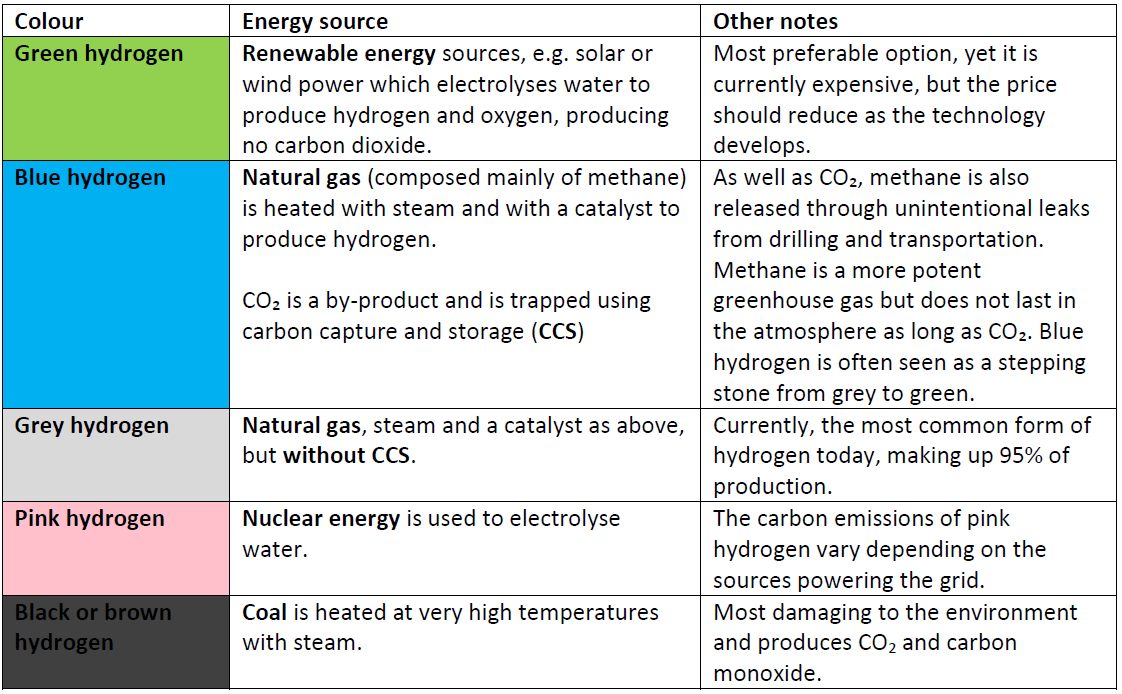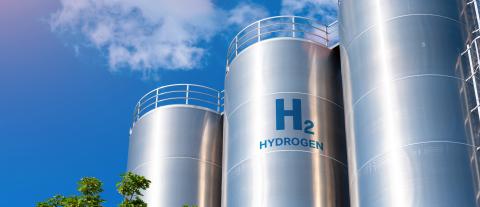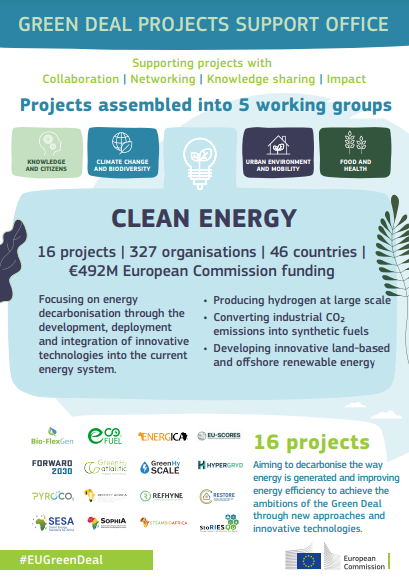Details
- Publication date
- Source
- Green Deal Projects Support Office
Imagine a future where our energy needs are met sustainably, without harming the planet or compromising our security. In the pursuit of this vision, green hydrogen has emerged as a potential game-changer within the European Union's (EU) ambitious energy strategy. With its potential to revolutionise the way we power our world, green hydrogen has captured the attention of policymakers, researchers, and industry leaders alike. By embracing green hydrogen at scale, the EU can drastically reduce its reliance on fossil fuels, paving the way for substantial greenhouse gas emissions reductions.
What are the main types of hydrogen?
The hydrogen industry has given colour codes to differentiate between the types of hydrogen based on how it was produced. The colours are expanding but the table below gives an overview of the main types.

Despite the green hydrogen industry being relatively infant, there are a few major applications that have already been developed. These include: replacing existing hydrogen feedstocks (that are not green), residential and commercial heating systems, energy storage and fuel cell vehicles. In the context of the EU, beyond the potential green hydrogen has in supporting a renewables-based electricity system, it would also help to accelerate the decarbonisation of energy-intensive industrial sectors that are unable to become carbon neutral via direct electrification; such as green steel or fertiliser production. Likewise, in the transport sector – given the limitations and costs of current battery technologies in aviation and shipping, for example – green hydrogen is a promising prospect for fuelling long-range hauls.
How does green hydrogen help tackle the energy crisis?
To recognise the importance of hydrogen in tackling the energy crisis, we must first understand its role when looking at energy reliability, security, and affordability.
Reliability
Green hydrogen’s impact extends far beyond its environmental credentials. As the EU endeavours to transition towards a low-carbon economy, it confronts the challenge of integrating renewable energy sources effectively. One of the major challenges for renewable energy is its intermittency – wind power is only generated when it’s windy and solar power is only generated when it’s sunny. Here, green hydrogen offers a versatile solution; a means to store and harness excess renewable energy so that when there is a lower supply than demand, the hydrogen reserves can be used. In simple terms, hydrogen offers a promising means for the storage and transport of energy.
As part of its 2030 Climate Target Plan , the EU Commission has substantially raised its ambition on reducing greenhouse gas emissions from 40% to at least 55% below 1990 levels by 2030 to ensure climate neutrality by 2050. Meeting these targets, without the broad adoption of hydrogen at scale, will be challenging.
The issue, however, lies in that green hydrogen technologies are not at an advanced enough stage to keep pace with the speed of renewable energy adoption. As EU countries bring more wind and solar farms online to replace fossil fuels, green hydrogen is still at the trial and development stage. Therefore, despite the potential benefits of green hydrogen working in tandem with other renewable energy sources, tackling the intermittency issues associated with them remains a long way off.
Nevertheless, as green hydrogen begins to scale up and reduce in costs, it could be a critical enabler of the European energy transition to renewable energy sources.
Security
Reducing greenhouse gas emissions and promoting renewables integration is an important driver, but so too is the question of energy security and independence. The EU currently relies heavily on imported fossil fuels, leaving it susceptible to price fluctuations and geopolitical tensions.
The invasion in Ukraine has demonstrated first-hand how reliant mainland Europe is on imported fossil fuels, particularly from Russia, and as such urgency has descended on policymakers to ensure the EU community maintains a secure source of energy for the continent. Prior to the sanctions imposed in 2022, the share of Russian energy in overall EU imports was 42.6% - more than any other country (Eurostat, 2020).
Enter green hydrogen. By prioritising domestic hydrogen production using renewable energy, the EU can enhance its energy security and reduce its dependence on external sources. This shift not only shields the EU from the risks associated with fossil fuels but also fosters a sense of independence, strengthening its position on the global stage.
Moreover, green hydrogen’s potential lies not only in its ability to power individual sectors but also in its capacity to bring them together. Through sector coupling[1] , green hydrogen unlocks opportunities for seamless integration across power generation, transportation, and industry As a versatile energy carrier, it has the potential to fuel zero-emission vehicles, decarbonise industrial processes, and provide heat in buildings. By decentralising the production and distribution of green hydrogen, the EU empowers local energy systems, nurturing regional resilience and energy autonomy.
There are already clear signs of the growth and maturity of hydrogen markets across the world, through the emergence of ‘Hydrogen Valleys’ - a geographical area in which there are several hydrogen applications and consumers clustered together into an integrated hydrogen ecosystem. Whilst most of the projects are located in Europe, over the past years, Hydrogen Valleys are located across the globe[2] and often involve collaboration between countries, fostering international partnerships for technology development and resource sharing. This cooperation can enhance diplomatic ties and promote energy security in regions with shared hydrogen infrastructure.
Affordability
The promise of green hydrogen extends beyond its environmental and security benefits. As the EU commits to developing and scaling this energy carrier, it opens doors to a world of economic growth and job creation. The development of a green hydrogen economy drives innovation, research and development, fostering the establishment of new industries and supply chains.
However, green hydrogen is a long way from being price-comparable with other renewable energy technologies. This is partly due to its current inefficiency in capturing the total energy produced and transforming it into usable power. According to the World Economic Forum, about 30 to 35% of the energy used to produce green hydrogen is lost during the process of electrolysis. A further 10% is then lost during transport and storage . When hydrogen is converted to electricity inside fuel cells, up to 50% of energy is lost . Although papers have shown differences in the data on the percentage decrease of energy in each phase of manufacturing, all of them agree that with an end-to-end efficiency of ~30%, hydrogen still has a long way to go in being efficient.
By investing in green hydrogen projects, from early-stage research and development through to implementation, the EU stimulates economic activity, attracts private investments, and generates high-quality jobs within the thriving renewable energy sector.
The EU’s Green Deal and Green Hydrogen
The European Green Deal has set the blueprint for transformational change. It aims to make Europe the first climate-neutral continent by 2050, while boosting the competitiveness of European industry and ensuring a just transition for the regions and workers affected.

Recognising the immense potential of green hydrogen in helping to achieve the aim set out in the Green Deal, the EU is embracing a multifaceted approach to promote its production, deployment, and use. The EU has devised a comprehensive framework of policies and initiatives aimed at unlocking the full potential of hydrogen. These efforts encompass financial support mechanisms, research and development programmes, and regulatory frameworks designed to foster innovation and accelerate the adoption of green hydrogen technologies.
By prioritising the production, deployment, and use of green hydrogen, the EU reinforces its position as a trailblazer in the global transition to a low-carbon economy.
Policies Driving Green Hydrogen Adoption in the EU
To ignite the transformative power of green hydrogen and propel its growth, the EU has launched several policies and financial support mechanisms. With the Hydrogen Strategy leading the charge, the EU aims to usher in a sustainable and carbon-neutral future, where green hydrogen is at the heart of industry, transportation, and energy storage. Similarly, the REPowerEU complements the Hydrogen Strategy to further increase the European ambitions for renewable hydrogen as an important energy carrier to move away from Russia's fossil fuel imports.
Other notable policies include :
Fit-for-55 package - introduced in July 2021, has several legislative proposals that operationalise the Hydrogen Strategy into a tangible hydrogen policy framework. Among these proposals are target-setting initiatives aimed at achieving the integration of renewable hydrogen in industrial and transportation sectors by 2030. It also includes the Hydrogen and Decarbonised Gas Market package (COM/2021/803 final and COM/2021/804 final), which outlines recommendations for fostering the development of specialised infrastructure for hydrogen and establishing a streamlined hydrogen market.
Important Projects of Common European Interest (IPCEIs) on hydrogen - These have been established to offer financial backing and drive the advancement of cutting-edge technologies across the hydrogen value chain. The overarching goal is to facilitate the decarbonisation of industrial operations and enhance the mobility sector, all while prioritising the needs of end-users. An illustrative instance is the endorsement, by the Commission in September 2022, of "IPCEI Hy2Use" as a complementary effort to the existing IPCEI Hy2Tech which sets the stage for supporting the creation of hydrogen-related infrastructure and the innovation of more sustainable technologies, specifically tailored to seamlessly integrate hydrogen into the industrial landscape.
NextGenerationEU - a recovery plan for Member States to invest in hydrogen projects across the value chain.
European Hydrogen Bank - aims to unlock private investments in hydrogen value chains, both domestically and in third countries, by connecting renewable energy supply to EU demand and addressing the initial investment challenges.
These policies are only a select few measures in an expanding legislative landscape, which demonstrates the commitment of the European Commission to developing green hydrogen. It is indeed integral in the EU’s strategy and efforts in achieving the Green Deal aims.
The Projects Advancing Green Hydrogen in Europe
The launch of the EU Green Deal has led to the Horizon 2020 Green Deal Call which supports research and innovation projects that advance the development of green hydrogen:
GreenH2Atlantic – creating a 100 MW hydrogen production hub in Sines, Portugal
GreenHyScale – building and operating the world’s first 100 MW green pressurized alkaline electrolysis plant
PyroCO2 - producing climate-positive acetone out of industrial CO₂ and renewable electricity derived hydrogen, thereby manufacturing chemicals and materials with a negative carbon footprint
REFHYNE - installing an electrolyser at an energy and chemicals plant, using renewable power to produce green hydrogen and oxygen, which will be fed back into the existing refinery networks to decarbonise its operations
Bio-FlexGen - developing a combined heat and power plant (CHP) with hourly, daily and seasonal flexibility as a result of producing hydrogen from biomass.
We spotlight two of these projects and key aspects that will help advance the development and adoption of green hydrogen:
GreenH2Atlantic
Demonstrating large-scale green hydrogen in industrial applications yyy
GreenH2Atlantic is an innovative project that aims to develop the lowest possible green hydrogen production cost in its first-of-a-kind 100 MW electrolysis plant in Sines, Portugal - supplying green hydrogen to a local refinery and blending it into the natural gas grid. The project is demonstrating the competitiveness of green hydrogen production whilst repurposing the existing infrastructures of a decommissioned coal-fired power plant. In this way, it contributes to Europe’s objective of reaching the GW-scale electrolysis needed for achieving decarbonisation targets, while ensuring a just transition for the region.
In addition to this, GreenH2Atlantic will promote the technical advancements of its electrolyser and support the research and development of other innovative features of the project such as the Advanced Hydrogen Management System, which will allow for the optimisation of the full hydrogen value chain in real time.
With sustainability as a guiding principle, the GreenH2Atlantic project aligns with the European Union's energy strategy. Supported by €30m funding from the Horizon 2020 research and innovation programme, the project serves as a catalyst for the widespread adoption of green hydrogen across Europe and is spearheading the development of a robust green hydrogen value chain. The GreenH2Atlantic project signals a new era of sustainable energy production, setting the stage for a cleaner and more resilient future for generations to come.
GreenHyScale
Sharing world-leading expertise

The GreenHyScale project embarks on a visionary journey to revolutionise green hydrogen production. By developing the world’s first 100 MW green pressurised alkaline electrolysis in GreenLab, Denmark, this project paves the way for a commercially viable hydrogen infrastructure with global replicability, both onshore and offshore.
Harnessing the power of pressurised alkaline electrolysis, GreenHyScale aims to transform a 6MW prototype module into a fully operational 100MW electrolysis plant. The chosen demonstration site, GreenLab, facilitates the sharing of surplus energy and resources among companies while transforming energy into heat, electrofuels, and other eco-friendly products.
Supported by a substantial €30m funding from the EU, the GreenHyScale consortium includes industry leaders, including Green Hydrogen Systems and Siemens Gamesa, all playing pivotal roles in the project's success.
With the promise of expediting Europe's journey toward carbon neutrality by 2050, GreenHyScale is poised to scale up the green hydrogen technological advancements, bringing us closer to a future where the cost of hydrogen matches that of fossil fuels.
Conclusion
Green hydrogen is emerging as a key component of the European Union's energy strategy, offering immense potential for achieving sustainable energy security and reducing greenhouse gas emissions. While the technology development and deployment at scale are still lagging behind other renewable energy sources, green hydrogen has the potential to transform various sectors, and contribute to decarbonisation efforts on a large scale.
As we have seen, ongoing Horizon 2020 Green Deal Call-funded clean energy projects demonstrate the EU's commitment to accelerating the adoption and deployment of green hydrogen across the region. These initiatives are vital in establishing transnational green hydrogen value chains and infrastructure, creating green hydrogen ecosystems, and showcasing the scalability and versatility of this renewable energy carrier.
The future of the hydrogen industry in the EU is poised for remarkable growth and transformation. With ambitious targets, comprehensive strategies, and substantial investments, the EU can position itself as a global leader in the hydrogen sector. The EU's commitment to fostering innovation, research, and development, coupled with strong regulatory frameworks and financial support mechanisms, creates an enabling environment for the hydrogen industry to thrive. Hydrogen is gaining traction across various sectors and will indeed play a pivotal role in achieving the EU's long-term climate goals and securing a clean, secure, and prosperous energy future for its citizens.
Find out more about the Green Deal-funded clean energy projects.
Footnotes:
[1] Sector coupling is a concept that addresses a potential design for the power industry of the future. It replaces the traditional separation of the energy sectors of electricity, heating and cooling, transport and industrial consumption processes with a more holistic and integrated approach. See more here.
[2] The Mission Innovation Hydrogen Valleys Platform is a useful tool that features comprehensive insights into the most advanced and ambitious Hydrogen Valleys and aims to facilitate information sharing on and between Hydrogen Valleys around the world to inform project developers, policy makers and the hydrogen industry alike.


